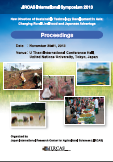Trend of Food Consumption, Marketing and Technological Development in Japan

Trend of Food Consumption
Annual and per capita gross supply of food has kept the level of 2,500 kcal for over 30 years in Japan. Mass
media often mention this tendency as “the age of plentiful food.” But the composition of consumed food has
changed gradually. Cereal consumption is continuously decreasing. Especially rice consumption has decreased
almost by half in recent 50 years. Instead meat consumption is increasing, but the trend of increase is not steep
like other Asian countries. The consumption level of Fish, Fruits and Vegetables (F&Vs) and Dairy products are
gradually decreasing. This trend is adverse to other Asian countries. The nutritional balance among Protein, Fat
and Carbonhydrate has kept as a proper level for health, but the ratio of fat is slightly increasing.
The externalization of diet is one of the typical characteristics in Japanese food consumption. Especially since
2000s, the expenditure on home meal replacement (HMR) has been increasing. The simplification of meal is
another important trend. For example, recent Japanese, especially young peole, do not eat fruits that are hard to
peel or big much. Instead, they prefer smaller or cut fruits. Otherwise they might buy other sweets.
Two important demographical trends have been affecting the changes of diet pattern mentioned above. First
is the continuing development of aging society. Different patterns of diet between aged people and the younger
generation can be observed on many types of foods. Second is the increase of the one-person household. The
single person usually prefers to eat outside or to buy HMR or repacked foods.
Trend of Food Marketing
Although some new and diversified marketing channels such as farmers’ markets and direct contracts have
developed, Japanese food marketing channel is still composed of multi-staged structure. But the bargaining
power has been shifted from the wholesale stage to the retail stage. Still the total sales at the retail sector have not
been increasing in recent years. Therefore, the large-scale supermarket chains have developed various types of
retail facilities, including big shopping malls, drugstores and discount shops, to attract more customers.
Over 50% of the customers select supermarket as the main channel to buy fresh produce. The ratio of food to
the total retail sales is still increasing in the supermarket chains. Most supermarket chains place importance on
the good assortment of food products.
Food safety is signified as the very important issue by both customers and retailers. Some large-scale retail
chains have been introducing the strategies to confirm the level of food safety and quailty, such as Good
Agricultural Production (GAP), traceability system and other inspection methods. This tendency requires the
agricultural and food manufacturing sectors to introduce related inspection systems and practice them continuously.
Expected Technological Development Related to Food Distribution
As both the one-person household and the aged people are increasing, it seems to be inevitable that the trend
of externalization and simplification will continue on the food market. R&D sector cannot ignore the tendency.
In addition, both consumers and food business sectors place more importance on food safety.
For example, the technology related to repacking or cutting foods into small units will be expected by both
manufacturers and retailers. The development of temperature control technology is also important both for fresh
food distribution and hot meal (including HMR) operation. In addition, if the technology of food inspection
develops and diffuses at a reasonable price, it would contribute to raise the level of food safety and trustful
relationships among the members of food industry.
But some of these technologies might cause more ecological burden. Japanese distribution system has achieved
quick delivery in a relatively small lot and brought benefits for customers, but this system also has been causing
various ecological burdens. New technology for reducing this burden on the environment should also be taken
into consideration.
| Date of issued | |
|---|---|
| Creator | Seiichi Sakurai |
| Subject |
externalization of diet simplification of meal supermarket chain food safety |
| Publisher | Japan International Research Center for Agricultural Sciences |
| Available Online | |
| Issue | 2013 |
| spage | 70 |
| epage | 80 |
| Rights | Japan International Research Center for Agricultural Sciences |
| Language | eng |
